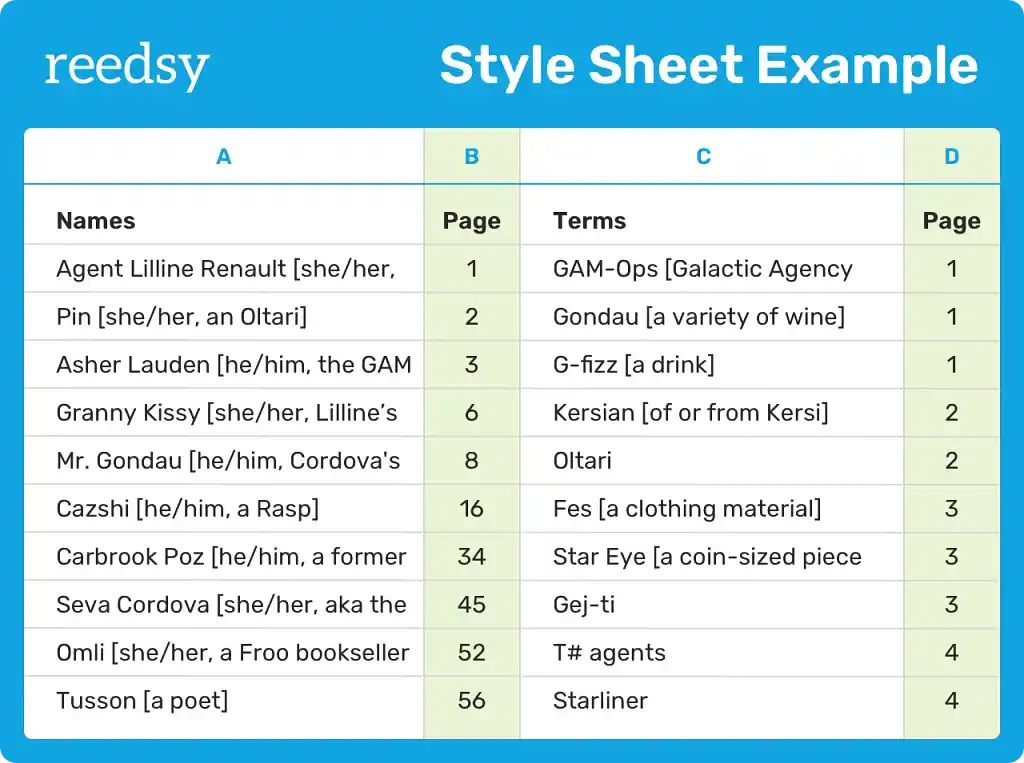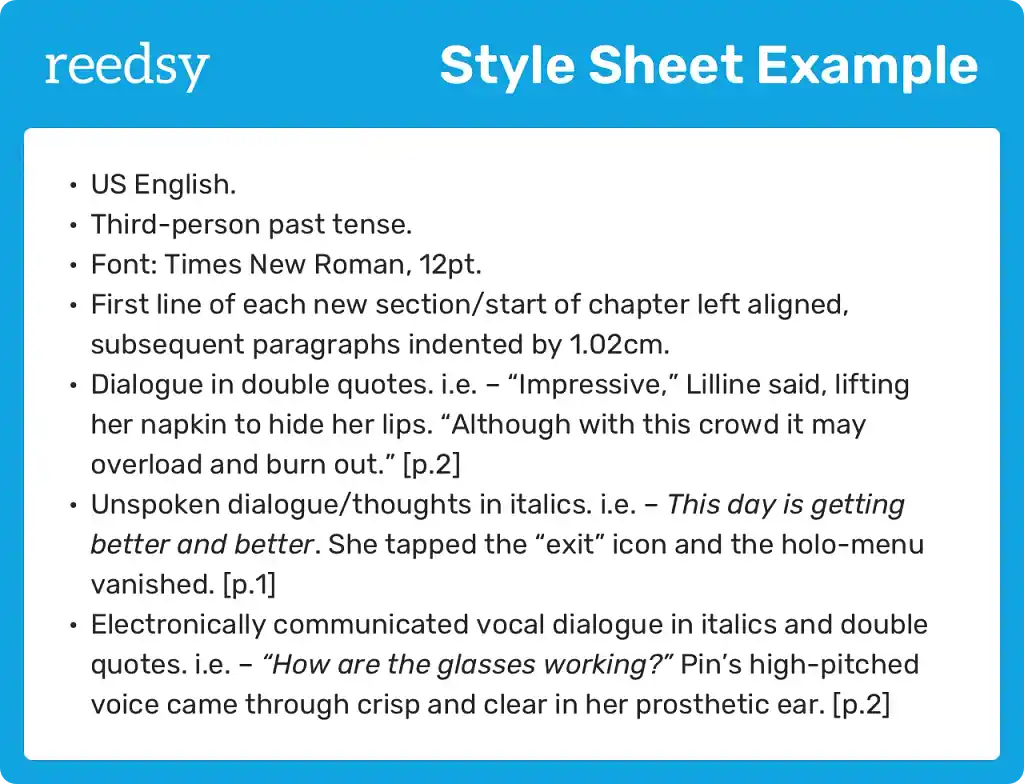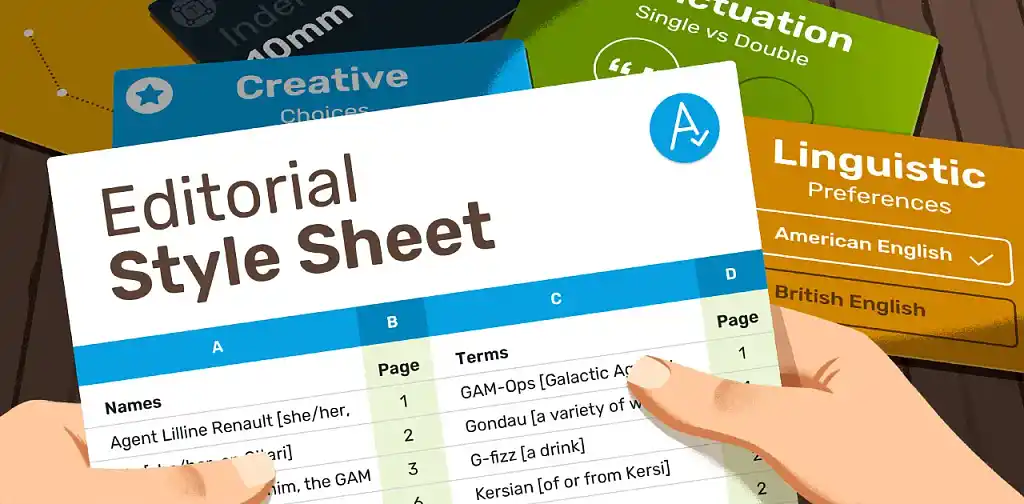Blog •
Posted on May 27, 2024
What Is an Editorial Style Sheet? [+Templates]
Linnea Gradin
The editor-in-chief of the Reedsy Freelancer blog, Linnea is a writer and marketer with a degree from the University of Cambridge. Her focus is to provide aspiring editors and book designers with the resources to further their careers.
View profile →A style sheet contains a list of editorial decisions to follow when editing a text. The purpose of a style sheet is to help an editor or author maintain consistency in things like grammar, spelling, and word choice throughout a single book, or even across a series of publications. It is usually based on a larger style guide, but is more customized to the specific project you’re working on, allowing you some creative freedom. But what exactly goes into a style sheet, and how do you create one for yourself?
In this article, we’ll outline the different components of an editorial style sheet, give you some tips on how to use it, and even provide you with two customizable templates to use for your upcoming projects.
Style sheets come after a style guide
Although some of the content may overlap, the functions of a style guide and style sheet are different. Style guides (such as Chicago or APA) include every tiny language detail that users should adhere to on a general basis, such as best practices for punctuation marks and their different usages. Oxford comma or no Oxford comma? Hyphen or dash? These are the types of fundamental guidelines that a style guide can provide. Because they are comprehensive reference guides, they aren't particularly accessible — often coming in at over one thousand pages — and are something editors or writers may go to for specific questions rather than use on the go.
Style sheets, on the other hand, focus on the main stylistic choices in the current text, rather than listing all possible language conundrums you can think of. This key information is usually created by the editor or author themselves and is intended to help them stick to their editorial choices, as well as help other collaborators maintain consistency throughout the process. It’s not so much about language correctness, but about uniformity.
Now, let’s look at some practical examples of what this might look like in real life.
They help you stay consistent
Style sheets are useful for both writers and editors as a place where they can quickly note down stylistic choices to remember for the current manuscript they’re working on. They outline a handful of spellings, punctuation, and other creative preferences. Let's take a look at Dune, the seminal science fiction novel by Frank Herbert, as an example.
Set over 20,000 years in the future, in a world where languages have evolved, many terms that Herbert uses in Dune are made up, such as Muad’Dib, Bene Gesserit, and gom jabbar – and that's just from the first page! All these words are uniquely created and their spellings must be kept consistent to keep readers engaged, so it’s likely that the editor assembled a style sheet to keep track. Beyond newly created words, there are plenty of linguistic and creative decisions that Herbert deploys as well, such as: ‘Voice’ being spelled with a capital V to distinguish the vocal powers of the Bene Gesserit from their normal speech, and always having internal thoughts written in italics.
Each of these decisions may seem small individually, but here’s another reminder that all the examples above are from the first page of a 500-page book. There are dozens of other decisions that an author and editor will need to keep track of that won’t necessarily be outlined in a style guide — and inform the proofreader and typesetter about — each of which had to be maintained not only in the first Dune novel but throughout Herbert’s entire 6 book saga.
So to summarize, here are the three main ways that style sheets are beneficial:
- Maintains consistency: Consistency is key to keeping readers engaged. You don't want them stopping to question whether Lady Jessica is the same character as Lady Jesica or why Lasguns have suddenly become Lazerguns. This consistency becomes even more important with a series where a sense of linguistic continuity helps keep each book connected.
- Keeps you organized: Rather than having editorial decisions scattered on post-its all over your office, or even just remaining in the author’s head, a style sheet is a great way to get all that key information organized in one place that is quick and easy to reference.
- Facilitates collaboration: You might have all the editorial decisions in your head, but when working with collaborators (like other editors and proofreaders) it’s important to have reference material that is quick and easy to share. This reduces any wasted time with back-and-forth questions and should make the whole process more straightforward as you hand over your work. Basically, it makes sure that everyone is always on the same page about any creative decisions that have been made and saves you some admin time.
Q: How can a style sheet help in the editing process?
Suggested answer
When most people think about an editor's work, fixing errors is probably the first thing that comes to mind. But the truth is, another huge component of any editing job is fixing things that aren't necessarily wrong -- they're just inconsistent. Are you Team Oxford Comma, or not? Do you prefer to spell out numbers all the way up to one hundred, or are numerals more your speed? And are those green veggies called scallions, or green onions? When these kinds of questions come up during the editorial process, a style sheet can help everyone involved to keep track of the answers.
As an editor, it's never my goal to impose my own preferences on an author -- instead, I want to learn what they prefer, and then make sure those choices are reflected consistently throughout their work. A style sheet helps me to do that as efficiently as possible, and also serves as a constantly evolving record of the decisions that have already been made. As the book is handed from development editor to copyeditor to proofreader, each editor can turn to the style sheet to learn the "rules," which are unique to every book and every author.
Christine is available to hire on Reedsy ⏺
A style sheet ensures consistency as a work goes through the editing process. It enables the copy editor, proofreader, and author to see what choices have been made at earlier stages so that they can preserve these preferences. It also prevents later editors from needing to reinvent the proverbial wheel, as they can reference an extant document. I reference a working style sheet to confirm idiosyncratic word spellings, punctuation and typography conventions, timeline events, and character traits as I read. (Yes, I've caught mid-novel changes in hair color, for example.) I always submit a style sheet to authors, as it explains many of the edits I've suggested in their work and saves on post-submission Q&A.
Jennie is available to hire on Reedsy ⏺
I would never edit without creating a style sheet in the process. It's there to keep me on track as I work and show me the changes I still need to make before I can consider the work finished.
Before I had the manuscript back to the editor, I add additional notes and explanations to help them understand the process and answer some of their questions, which is then useful when we discuss the edit. I also find style sheets incredibly useful when I'm jumping between different projects and when I return to working with the same author again in the future.
Mairi is available to hire on Reedsy ⏺
Now that we’ve seen the value of using style guides, let's see how they're useful for different genres.
Style sheets are useful for all genres
Style sheets are well worth taking the time to create for all genres of writing, from fantasy novels to non-fiction science books.
Fiction
With fantasy or sci-fi novels, there will undoubtedly be varied character names as well as made-up terminology for places, weapons, and ancient artifacts! Going back to our example of Dune, Herbert often creates terms by combining words from other languages or crafts entirely fictional words for new concepts: lasguns are energy weapons, the Sardaukar are elite fighters, and Arrakis is the desert planet known as Dune. These dozens of new words can be easy to lose track of or slightly misspell, but style sheets help keep everything in order.
Non-fiction
Factual text will often include plenty of specific terminology or abbreviations that need to be confirmed and kept track of. Let's take a look at Sapiens by Yuval Harari which includes plenty of technical terminology like Lascaux Cave, Sungir, Göbekli Tepe. Using the correct term with the correct spelling is important for non-fiction books to maintain the author’s authority and trust in the subject. Once an editor has checked the terms, they can note them down clearly in their style sheet and save themselves from having to Google or use an enormous style guide each time they’re in doubt.
They should be functional and personalized
As we’ve seen, the main purpose of a style sheet is to help you work more efficiently. There’s no right or wrong way to design it: its most important feature is that it should be personalized to the specific project you’re working on. That means that style sheets vary widely. Nonetheless, there are a few common components that you’ll often come across in any style sheet.
Freelance editor Jon Oliver set up the style sheet for one of his projects like this, in a spreadsheet format:

Linguistic preferences, e.g.
First of all, many style sheets will start by noting which style guide it uses as its base and whether the text is in American or British English. Some other linguistic preferences that you might want to mark down include:
- Writing style (academic, casual, etc.)
- Numbers and date formats
- Terminology e.g. OK vs. okay
- Preferred abbreviations
Punctuation, e.g.
Though the style guide will govern how punctuation is used, some editors prefer to include some quick references to how punctuation is used in the current text too, such as:
- Single vs. double quotation marks
- Ellipses spacing or not
- Oxford comma or not
- Sentence case vs. title case
Creative choices, e.g.
The bulk of a style sheet should be focused on the creative choices that you can’t find outlined in a style guide, like:
- Made up words and names
- Overall timeline of events
- Formatting and layout, e.g. use of italics
Creating a style sheet is a running process, with new entries being added as you go through the text. Depending on your needs, it can be as simple as a list of bullet points and a couple of headers to keep it organized, or a more complex spreadsheet. The layout and where you choose to set up your style guide is entirely up to you. You could keep it analog, if it pleases you, though setting up a simple Word document or Google Doc might be more convenient for everyone.
Here’s another example of how editor Jon has set up a style sheet, this time in a Word document:

Regardless, the best way to structure your style sheet is to break it down into easy-to-digest sections and divide it into headings that make sense to you. This will help keep the author, the editor, and anyone else collaborating on the piece on the same page when it comes to all editorial decisions.
Q: What elements do you prioritize in a style sheet?
Suggested answer
My style sheets are fairly comprehensive. They're organized into the following categories: Resources (Merriam-Webster, Chicago, etc.), Punctuation (use of commas, dashes, ellipses, and so on), Typography (what gets italicized, what uses roman font and quotes), Capitalization, Miscellaneous (which/that distinction, further/farther distinction, any grammar rules that don't fit neatly in other categories), Numbers, Terms (vocabulary particular to the work). If a project has a robust cast of characters, I add a list of them and note personal traits, like age and hair color, if these need to be tracked. If there's a complex timeline or timeline tangles, I include a timeline of relevant events with page numbers for ready reference. Finally, I note any general rules or authorial idiosyncrasies of which future readers (like proofers) should be aware: British vs. American English, author preference for uncommon treatment of terms, author use of nonstandard grammatical constructs like frequent sentence fragments, and such.
Jennie is available to hire on Reedsy ⏺
My style sheet includes quite a few different elements, including:
- Spelling preferences for words that have multiple options
- Character names and profiles, noting everything we learn about that character over the course of the story and what page we learn it on
- Place names, with descriptions
- World-specific terms, as well as their meanings
- A brief summary of every chapter and scene throughout your story
- Grammatical and citation rules that are followed
- Lists of important information that I might need to keep track of, like all the countries mentioned, or each member of the king's council, or what the prophecy says, word for word
My style sheet is meant to help me take notes during the process of editing, but also helps you, the author, learn best practices, understand what I've changed, and keep things streamlined, particularly across multiple books. If I work with you on a second book, then, it shifts into more of a series bible, where all information is compiled across all books to ensure total consistency.
Jessica is available to hire on Reedsy ⏺
Let's face it: some book categories are positively anal. (I'm looking at you, Children's Picture Books.)
But even for those, there are decades of practicality that underlie the surface "rules."
For example: most beginning picture book writers don't understand how to write for artists, so except for including bland imagery that can't be sussed from the text, they should leave it alone.
Also in picture books, writers shouldn't try to find artists; that's the purview of the editor, who has a broader commercial and aesthetic range. If the writer understands that the editor is the fulcrum of the process, then it's easier to understand why she/he should be careful not to overstep.
For novelists, there are some standards that need to be adhered to, and some really good reasons for it. If you search online, you'll see numerous different cover sheet formats, and that can be confusing, until you realize that most of them contain the same information; then you can choose what you prefer. (I like the Reedsy manuscript format, which seems to cover most of them.)
But then we get to the formatting that needs to be strictly adhered to: 12 pt. New Times Roman, double-spaced.
What's that about?
Well, here's the thing: if you put yourself in the editor's position, how would you like to read a hundred different manuscripts with a hundred different fonts at a hundred different sizes that can have any space between lines?
The answer is: you wouldn't. The important thing about identical formatting is that it allows the work to stand out and speak for itself. Also, there's a practical tradition of having double-spacing between lines to leave room for editorial notes.
Onto comics and graphic novels.
There's an industry truism about comics: there's no one way to write a comic; there's only the finished result.
So here's what's important: clarity and consistency. I can't tell you how hard it is to accomplish those simple three words.
If a script is clear in it's direction to the artist (not complicated; clear) and consistent in its use and execution, then it will be well-written. The goal here is to write a script that will be perceived the way it is intended to be perceived, not just by the artist, but also by the editor and the comics reader. That is so much harder than it sounds.
For writers who clearly haven't yet learned to "think comics," I offer a tried and true style sheet that makes the work ten times easier than trying to write comics like movies, which is what I mostly see.
Ultimately, for any style sheet format, if you don't follow formatting "rules," then it means you haven't done your homework, and that's not a great first impression.
Lee is available to hire on Reedsy ⏺
Style Sheet Templates
If you're looking for some inspiration to get your own style sheets started, we've put together two templates that you can download for free below:

FREE RESOURCE
Editorial Style Sheet Templates
Set up a sleek and easy-to-use style to keep track of all your creative decisions.
We hope you find them helpful.
For information about how to showcase your expertise, get more freelance clients, or notifications about free webinars, check out our blog and follow us on LinkedIn.
Reviewed by Martin Cavannagh
Head of Content at Reedsy, Martin has spent over eight years helping writers turn their ambitions into reality. As a voice in the indie publishing space, he has written for a number of outlets and spoken at conferences, including the 2024 Writers Summit at the London Book Fair.
As the host of Reedsy Live, Martin has had the pleasure of sharing cutting-edge insights from some of the world's best editors, designers, marketers, and the occasional bestselling author. His newsletters, live streams, and blog posts reach millions of writers each month, inspiring the next generation of beloved writers.
Martin has appeared on various panels (both virtual and in-person), including the Writer's Summit at the 2024 London Book Fair. Outside of books, his interests include hillwalking, the films of Wong Kar-Wai, and discovering great local noodle dishes.

